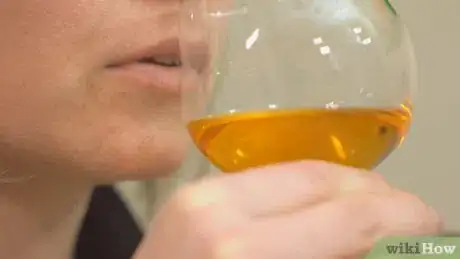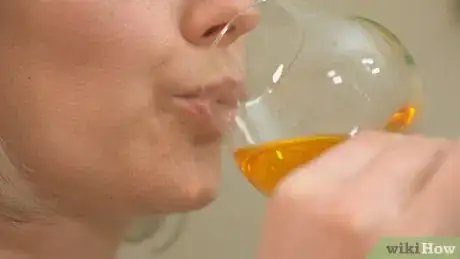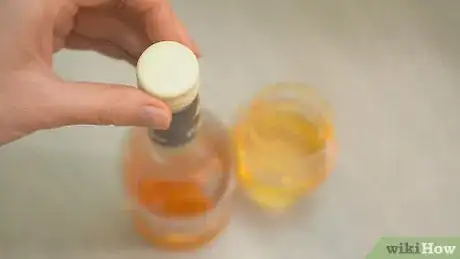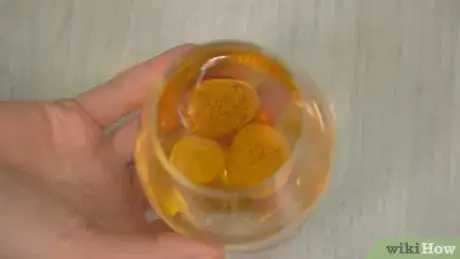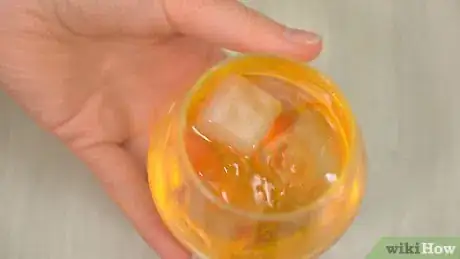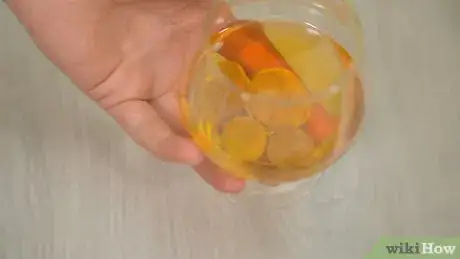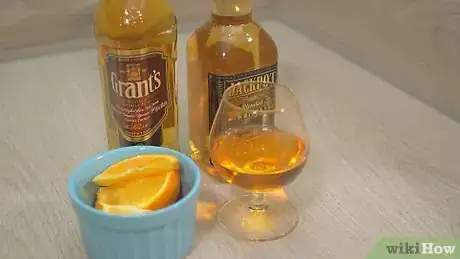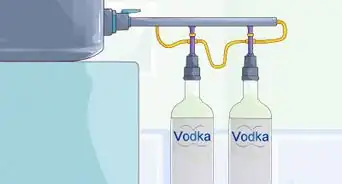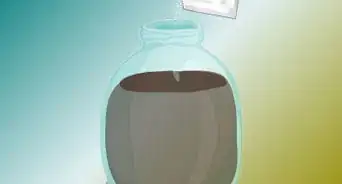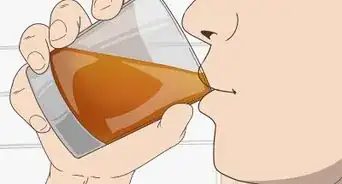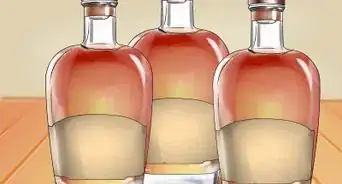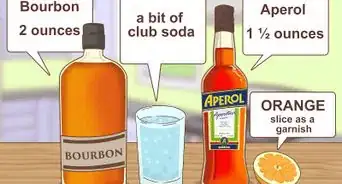This article was co-authored by Tom Blake and by wikiHow staff writer, Hannah Madden. Tom Blake manages the bartending blog, craftybartending.com. He has been a bartender since 2012 and has written a book named The Bartender's Field Manual.
There are 20 references cited in this article, which can be found at the bottom of the page.
wikiHow marks an article as reader-approved once it receives enough positive feedback. In this case, 100% of readers who voted found the article helpful, earning it our reader-approved status.
This article has been viewed 467,086 times.
Scotch whisky inspires a near cult-like devotion in some drinking circles. Known for its pungent aroma and long, lingering finish, it's mostly designed to sip, not shoot. While all whisky (or "whiskey") can be enjoyed responsibly by anyone with an interest in spirits, Scotch whisky is best enjoyed with a little splash of water and a gathering of friends. If you've poured yourself a wee dram and wish to savor its silky texture in a whole new light, read on.
Steps
Familiarizing Yourself with Scotch Basics
-
1Distinguish the single-malts from the blends. One of the most important distinctions in Scotch whisky is a technical one. It may not seem terribly important, but being able to identify a single-malt from a blend will tell you a lot about the whisky before you even sip it. So, what is the difference between single-malts and blends?
- A single-malt Scotch is made just from water and 100% barley. Although it comes from a single distillery, it can contain whiskies from different barrels, and even from different batches.[1] A single malt from Bruichladdich distillery, therefore, may have whiskies from different barrels, but it will only contain whisky distilled at Bruichladdich.
- A blended malt Scotch whisky is made from 2 or more single-malt whiskies produced at different distilleries.[2] Many distilleries sell their whisky for use in blends. Few independent bottlers identify which distilleries produced the whiskies made in their blends, preferring instead to name only the general geographical area.
-
2Give blends a chance. Although single-malts are arguably more prestigious than blends—their price tag certainly advertises it—there are some very tasty blends out there, sometimes even nicer than single-malts. Overall, you'll probably squeeze more quality out of single-malts, but they're more expensive than blends and not always better.[3]
- Usually, distilleries will combine whiskeys together in a blend to add a more robust flavor profile. You could actually get a more interesting taste if you go with a blend rather than a single-malt.
Advertisement -
3Go for old scotch whisky that’s been aging for a while. Scotch whisky ages for at least 3 years in oak barrels. Sometimes, those oak barrels have been previously used to age sherry or bourbon. The provenance of the oak itself often varies: some distilleries use American oak casks, while others prefer European oak. The process of allowing the whisky to age in oak barrels, sometimes for several decades, often produces a finer whisky. As a wise man once said, "Never commit Scotch pedophilia!"[4]
- Why does whisky improve with age? Oak, like all woods, is porous. Scotch that is housed in oak barrels seeps into the oak barrel's pores, picking up some of the oak's unique flavor. As the whisky ages, a portion of the alcohol evaporates, mellowing the flavor. The whisky that evaporates during the aging process is referred to as the "angel's share."
- Scotch whisky barrels are sometimes charred before the introduction of the spirit. This charring imparts a unique flavor. The charred wood also helps purify the whisky; the carbon left in the charcoal filters away some impurities as it ages.
- Whiskies are often given a "finish," so to speak. They are aged in one cask for a majority of the aging process, and then transferred to another cask for an additional 6 to 12 months. This gives the whisky a richer flavor profile.
- Whisky does not continue to age once it is bottled. It may lose a bit of alcohol through evaporation and therefore "mellow," but most of its deep flavor is likely to have developed while it was still casked.
-
4Look for all-natural whiskys without added colorants. Some whiskies are given caramel color injections before bottling, ostensibly to maintain visual consistency from one bottling to the next. Steer clear of these whiskies. Here's the bottom line with Scotch and with other spirits to which colorants are added: If the distiller or bottler is willing to lie about the color of the spirit, what else are they willing to lie about?[5]
- Scotch whisky experts have debated about whether or not the colorant affects the flavor profile. While the usual consensus is that it doesn’t, some purists maintain that you can taste the difference between a colorant whisky and an all-natural one.
-
5Note where the Scotch comes from. While whisky can technically be produced the world 'round — Canada, Australia, and even Japan all make fine whisky — start off with whiskies from the wind-tipped rim of Scotia. You almost can't go wrong. Here's a quick look at the different regions of Scotland, some of their characteristics, and some of their most heralded whiskies:
| Region | Distinctive Regional Flavors | Representative Brands |
|---|---|---|
| Lowland | Light-bodied, gentle, malty, grassy | Glenkinchie, Blandoch, Auchentoshan |
| Highland | Firmer, spicy, both dry and sweet | Glenmorangie, Blair Athol, Talisker |
| Speyside | Sweet, mellow, often fruity | Glenfiddich, Glenlivet, Macallan |
| Islay | Heavily peated, smoky, spindrift | Bowmore, Ardbeg, Laphroaig, Bruichladdich |
| Campbell | Medium- to full-bodied, peaty and briny | Springbank, Glen Gyle, Glen Scotia |
Nosing, Sipping, and Savoring
-
1Get the right whisky glass. While it's certainly fine to drink your whisky out of any old glass, choosing the right one will enhance your whisky experience. Experts agree that a tulip-shaped glass is generally the best: It allows you to swirl the whisky without it spilling, as well as concentrating the whisky aroma near the glass's neck.[7]
- If you can't find a tulip-shaped whisky glass to sip out of, try using a wine or champagne glass instead.
-
2Pour a small amount of whisky and swirl it around gently. Pour yourself a glass about 1 fl oz (30 mL) full of scotch whisky. Gently swirl the glass, coating the sides of the glass with a thin film of whisky and allowing the spirit to breathe. Enjoy the color of the whisky and its texture as the filmy coat of caramel spindles down the glass.[8]
- Enjoying whisky is much more than just tasting it. It’s about the look, the color, and the texture, too.
-
3Bring the glass up to your nose and inhale deeply. Smell your whisky with your mouth slightly open to fully appreciate the aroma. Take your nose away (the first nose will smell entirely of alcohol) and then come back to the whisky. Spend a good 20 to 30 seconds breathing in the whisky, setting it down, and coming back to it, all while free-associating about the kinds of smells or flavors the spirit evokes. When nosing, pay attention to the following kinds of smells:[9]
- Smokiness. This includes peatiness, as malted barley is often thrown over a peat fire in order to smoke it.
- Saltiness. Can you taste the briny spindrift of Islay whiskies? Many Scotch whiskies have a distinctly maritime smell.
- Fruitiness. Can you pick out dried currants, apricot, or cherry from your whisky?
- Sweetness. Many Scotch whiskies rely on caramel, toffee, vanilla or honey tones.
- Woodiness. Since oak is such an integral companion in the whisky-aging process, wood smell is often headily present in Scotch. It sometimes interacts with the smell of sweetness.
-
4Take a tiny sip. Bring in enough whisky so that it coats your entire tongue, but not so much that your taste buds are overwhelmed with the flavor of alcohol. Swirl the Scotch around in your mouth a bit and try to develop a good "mouthfeel." How does the whisky taste? What does it taste like?[10]
- Your first sip may be overwhelmed with the taste of alcohol, but try to delve deeper into the different notes and tones of flavor.
-
5Savor the finish. Swallow the whisky and open your mouth slightly to help taste the lingering afterglow of the whisky. What flavors, if any, develop after the whisky has been swallowed? This is referred to as the "finish." In elegant whiskies, the finish will be distinct from the mouthfeel, and will add another layer of pleasant complexity to your tasting experience.[11]
- You can also use this “finish” to figure out if you need to add water or not.
-
6Add a small amount of water to your whisky. Many whisky aficionados like to add water to their whiskey, enough to dilute the alcohol volume down to about 30%. This is usually less than 1 teaspoon (4.9 mL). Some whiskies will take more water, other will take less; as with most things delicate, it's better to add too little than too much.[12]
- Here's a tip for determining how much water to add to your whisky. Add a couple drops at a time until the stinging or burning sensation in your nose you get from smelling the alcohol disappears.
- Why add water to your whisky? Water dilutes the whisky. At stronger alcohol contents, the alcohol in the whisky can mask some of the more unpleasant flavors or aromas. When you take that heady alcohol smell and taste away, the true spirit of the whisky starts to shine through.
- Try covering the whisky with a cap of some sort (try a clean coaster, for example) and let it mellow for 10 to 30 minutes. This will give the whisky enough time to interact with the water, producing a better drinking experience.
-
7Repeat the whole process, this time with the diluted whisky. Swirl, nose, taste, and savor the whisky again. How does it taste diluted? How is the whisky any different from what it was undiluted? What things do you notice now about the whisky that weren't apparent on the first pass? Continue drinking and savoring the whisky slowly, preferably with friends.[13]
- Whisky is a sipping drink. While there’s no set time limit for how long it should take you, you should savor and enjoy your glass, not gulp it down. Take it slow to really experience scotch whisky and all it has to offer.
Enhancing the Scotch Drinking Experience
-
1Make your own blends. Who says you have to rely on distilleries to blend the whisky for you? You can make your own blends quickly and easily, and to good effect with a little bit of practice. Here's the basics of how.[14]
- Start with 2 whiskies, preferably from the same distiller. Two different kinds of Bruichladdich might work well together, or two different vintages of Talisker. It's easier to blend whiskeys that were sold by the same distiller.
- Blend a very small amount of 2 or 3 whiskeys and set aside for a week or 2. This is your "test run," designed to see whether you enjoy the final product. If, after 2 or 3 weeks, you like the blend, you can be reasonably sure that blending more won't result in total disaster.
- Take an empty whiskey bottle and fill it almost to the brim with your new blend. You can use 50/50 of 2 whiskies, or 45/55, or even 33/33/33 of 3. The choice is yours. Filling your bottle up almost to the brim neutralizes some of the oxidation that can affect the taste of your whisky.
-
2Drink your whisky within 1 year once you open the bottle. As soon as you expose your precious whisky to O2, the spirit starts losing some of its character. Oxygen starts converting the alcohol into vinegar. So drink responsibly, but don't sip so slowly that your cargo turns into undrinkable acid. Bottoms up![15]
- You can keep unopened whisky around for a really long time (almost indefinitely) as long as you keep it cool and out of direct sunlight.
-
3Experiment with wood-aging yourself. Whisky is aged in oak barrels, but the whisky entrepreneur can also learn how to age spirits himself using string and a toasted twig of wood. Try experimenting with woods such as birch, cherry, or oak for extra flavor. Of course, only use this technique to enhance whisky that leaves something to be desired; very good whiskies probably won't benefit from extra wood aging.[16]
- Make sure the branch or twig is small enough so that it will fit inside your whisky bottle.
- Heat your branch or twig in the oven for several hours on low heat to remove all moisture.
- With a blowtorch, lightly toast the branch. The goal here isn't to char; you just want to toast the branch or twig to give it extra aroma.
- Fasten the branch to a piece of string and submerge it in your whisky, tasting the whisky every 30 minutes. You don't need to submerge the branch long to have a big effect on taste: 30 minutes to an hour is sometimes all it takes to produce a nice enhancement.
- Note: Be sure that the type of wood you're using is safe to use in whisky. Some types of wood are poisonous to humans and/or won't produce a pleasant taste or aroma. Your health should always be your first priority.
-
4Try to refrain from adding ice. Of course, if you like your whisky cold and super-diluted, go for it. But most whisky drinkers consider ice to be passé. Cool temperatures tend to mask certain flavors, and over-diluted whiskey is more water than whisky, anyway, right?[17]
- If you really want your whisky cold, try using whisky rocks instead. They can be put in the refrigerator or freezer and, if manufactured properly, don't leave an aftertaste.
-
5Try your hand at starting your own whisky collection. Of course, if you're just a beginner, this may seem a bit odd. But many people consider whisky collecting a fun and enlightening hobby. Here are a couple things for you to consider when starting your own collection:[18]
- Buy what you enjoy drinking, not what you think will be worth big bucks later on. The whisky auction market is quite volatile. Prices fluctuate often. The best bet for collecting is to stick what you like; that way, if the price of whisky plummets in 10 years, or doesn't outstrip inflation, you'll still be happy drinking your whisky.
- Keep your receipts. Keep your receipts in the whisky bottle itself. It's a nice little reminder of what you paid, and helps you enjoy the whisky more once you finally decide to pop the cork.
- Keep your stash in different places. If a snooping child or a devastating fire were to hit your stash, it pays to diversify. Don't keep your eggs all in one basket.
Serving Scotch Whisky
-
1Add ice if you’re just getting into whisky. While whisky purists often turn up their nose at adding ice, it can help to cool down the drink and dilute it a little bit to avoid a burning sensation as you drink. Always use pure, clean ice made from filtered water, and only add 2 to 3 cubes at a time to avoid watering down the good stuff too much.[19]
- Adding ice can mask some of the flavors in the liquor, so you might not be getting the full profile.
- Use large ice cubes that melt slowly so you have time to finish the whisky before they all melt.
-
2Try whisky stones to cool the drink without diluting it. If you love cold whisky but you don’t want to water it down, buy some whisky stones and keep them in your freezer. Then, add them to your drink any time you want a cool, refreshing sip of whisky. The stones are made of, well, stone, so they won’t melt, but they will chill your drink.[20]
- Try to chill your whisky stones in the freezer for at least 4 hours before using them so you get the most refreshing coolness in your drink.
-
3Blend your whisky into a cocktail to enhance the flavor. If you aren't a fan of drinking straight liquor, you can incorporate whisky into a fun, flavorful cocktail with a strong alcohol content. Try making a scotch and soda for a quick cocktail that’s easy to customize, or a rusty nail for a classic cocktail with only a few ingredients in it.[21]
- You can also add scotch whisky to cocktails that don’t usually include it, like using whisky instead of rye liquor in a manhattan.
-
4Dilute the whisky with water to get rid of the alcohol sting. If you really want to enjoy the flavors of your whisky, you might be distracted by the burning in your nose as you sip it. Consider adding a little bit of water, 1 drop at a time, until the alcohol burn goes away. Water will actually open up the flavor of the whisky, making it tastier and easier to drink.[22]
- Try not to go overboard with the water—adding more than a splash can dilute the whisky and mask the flavors. It’s all about finding that balance.
Expert Q&A
Did you know you can get premium answers for this article?
Unlock premium answers by supporting wikiHow
-
QuestionHow much a single malt can be taken in a day and how many times in a week?
 Tom BlakeTom Blake manages the bartending blog, craftybartending.com. He has been a bartender since 2012 and has written a book named The Bartender's Field Manual.
Tom BlakeTom Blake manages the bartending blog, craftybartending.com. He has been a bartender since 2012 and has written a book named The Bartender's Field Manual.
Professional Bartender
-
QuestionWhat are good mixers with Scotch?
 wikiHow Staff EditorThis answer was written by one of our trained team of researchers who validated it for accuracy and comprehensiveness.
wikiHow Staff EditorThis answer was written by one of our trained team of researchers who validated it for accuracy and comprehensiveness.
Staff Answer wikiHow Staff EditorStaff AnswerScotch goes well with a variety of mixers. You can stick to the two basics of water or plain soda, or you can add such liquids as coconut water, ginger ale, cola, flavored sodas (citrus varieties are especially good choices), apple juice or apple cider, lemonade, etc. If you want an alcoholic mixer, Drambuie, Disaronno or Amaretto make good choices. Any mixer with a sugary base will sweeten the taste of the Scotch, while water or plain soda will dilute the strength (see the explanation on adding water in the steps above). And if you like spices, a tiny sprinkling of nutmeg atop the whisky can be a nice touch.
wikiHow Staff EditorStaff AnswerScotch goes well with a variety of mixers. You can stick to the two basics of water or plain soda, or you can add such liquids as coconut water, ginger ale, cola, flavored sodas (citrus varieties are especially good choices), apple juice or apple cider, lemonade, etc. If you want an alcoholic mixer, Drambuie, Disaronno or Amaretto make good choices. Any mixer with a sugary base will sweeten the taste of the Scotch, while water or plain soda will dilute the strength (see the explanation on adding water in the steps above). And if you like spices, a tiny sprinkling of nutmeg atop the whisky can be a nice touch. -
QuestionCan you mix Sprite lemonade with Scotch?
 wikiHow Staff EditorThis answer was written by one of our trained team of researchers who validated it for accuracy and comprehensiveness.
wikiHow Staff EditorThis answer was written by one of our trained team of researchers who validated it for accuracy and comprehensiveness.
Staff Answer wikiHow Staff EditorStaff AnswerYes, Sprite lemonade or other carbonated lemon/lime soda drinks make an excellent mixer for Scotch. It is best used with a lighter flavored Scotch and don't forget to add a wedge of lime to finish it off nicely. Also, this is best reserved for cheaper varieties of Scotch; the more you pay, the more it pays to savor the Scotch without mixers.
wikiHow Staff EditorStaff AnswerYes, Sprite lemonade or other carbonated lemon/lime soda drinks make an excellent mixer for Scotch. It is best used with a lighter flavored Scotch and don't forget to add a wedge of lime to finish it off nicely. Also, this is best reserved for cheaper varieties of Scotch; the more you pay, the more it pays to savor the Scotch without mixers.
References
- ↑ https://drinks.seriouseats.com/2012/02/what-is-single-malt-scotch-what-is-blended-whisky.html
- ↑ https://www.youtube.com/watch?v=RwzO1ZMBJ9o&feature=youtu.be&t=27
- ↑ https://www.youtube.com/watch?v=RwzO1ZMBJ9o&feature=youtu.be&t=86
- ↑ https://www.scotch-whisky.org.uk/discover/faqs/
- ↑ https://vinepair.com/wine-blog/why-there-is-food-coloring-in-your-expensive-whiskey/
- ↑ https://www.scotch-whisky.org.uk/discover/distillery-map/
- ↑ https://www.youtube.com/watch?v=d6jkDGiBvuo&feature=youtu.be&t=19
- ↑ https://www.youtube.com/watch?v=euSNQ5SqgeI&feature=youtu.be&t=65
- ↑ https://www.youtube.com/watch?v=euSNQ5SqgeI&feature=youtu.be&t=70
- ↑ https://www.youtube.com/watch?v=s2BnmaFAAT4&feature=youtu.be&t=159
- ↑ https://www.youtube.com/watch?v=s2BnmaFAAT4&feature=youtu.be&t=188
- ↑ https://www.youtube.com/watch?v=eyJdrj4om7o&feature=youtu.be&t=43
- ↑ https://www.youtube.com/watch?v=s2BnmaFAAT4&feature=youtu.be&t=178
- ↑ https://www.whiskyadvocate.com/blend-house-whisky/
- ↑ https://www.whisky.com/information/knowledge/about-whisky/storage/does-whiskey-go-bad.html
- ↑ https://vinepair.com/articles/best-wood-whiskey/
- ↑ https://vinepair.com/articles/how-drink-scotch-according-scottish-bartender/
- ↑ https://medium.com/@PeteWeishaupt/things-to-consider-when-starting-a-whisky-collection-35651a7a70fe
- ↑ https://vinepair.com/articles/how-drink-scotch-according-scottish-bartender/
- ↑ https://www.esquire.com/food-drink/drinks/a32690080/whiskey-stones/
- ↑ https://vinepair.com/articles/how-drink-scotch-according-scottish-bartender/
- ↑ https://www.esquire.com/food-drink/drinks/a14244/scotch-drinking-tips-053012/
About This Article
To drink Scotch whisky, start by pouring 1 fluid ounce of whisky into a tulip-shaped glass. Then, gently swirl the whisky around in the glass to allow it to breathe. Next, smell the whisky with your mouth open, noting any smoky, sweet, woody, or fruity smells. After you smell the whisky, take a small sip and swirl it around in your mouth to pick up on the taste and texture. Finally, swallow the whisky and pay attention to the aftertaste, which is also known as the "finish." To learn how to choose good Scotch whisky, keep reading!





